What do we know about whales
Whales in the game analytics are called users who pay very large sums of money. At the same time, there is no certain amount, having spent that, the user becomes a whale - each project determines this value itself.
Whales bring a significant portion of the game's income. You all know the Pareto principle (20% of efforts give 80% of the result), and in game analytics this principle can be formulated like this: 20% of paying users give 80% of the game’s income. In other words, a small number of paying users brings a significant share of the total revenue of the game. In particular, in a recent study published on Venturebeat, it says that 0.19% of players bring in half of game income.
Here's what the report on segments of paying users looks like in devtodev . We have identified a separate category, Grand Whales (the top 1% of those who pay the most).

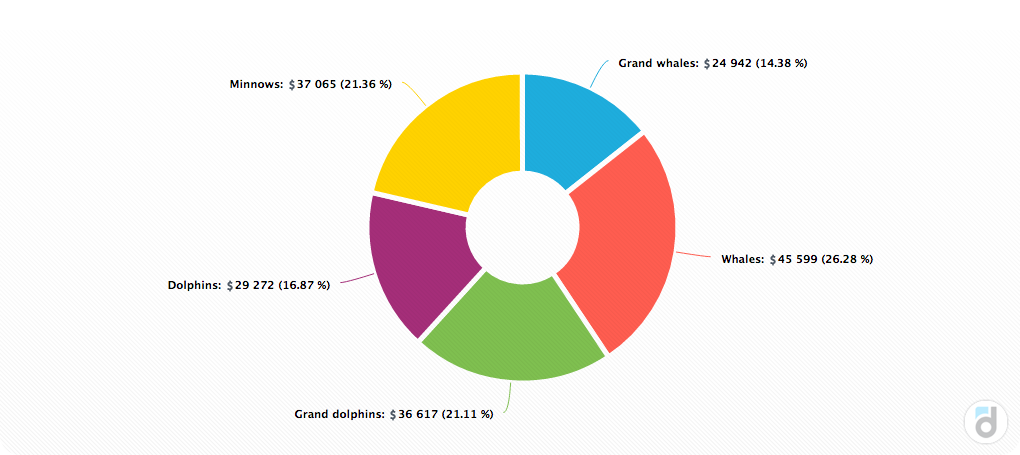
')
This question is often asked by analysts. If the answer was so simple, all the whales would have been taken apart for a long time. You need to understand that the whale in your networks is an unlikely event, and it is difficult to predict it (just about how to predict an earthquake).
Moreover, if suddenly you found out that a whale “swelled” through one of the traffic channels, this does not mean that the entire marketing budget should be directed to this channel. Rather, on the contrary, when analyzing the quality of the traffic channels of this whale, it is better to deduct it so that it does not spoil the statistics.
Try searching for whales through analyzing your project by country or platform. Here, for example, statistics from Newzoo on the percentage of players who pay large sums by country.
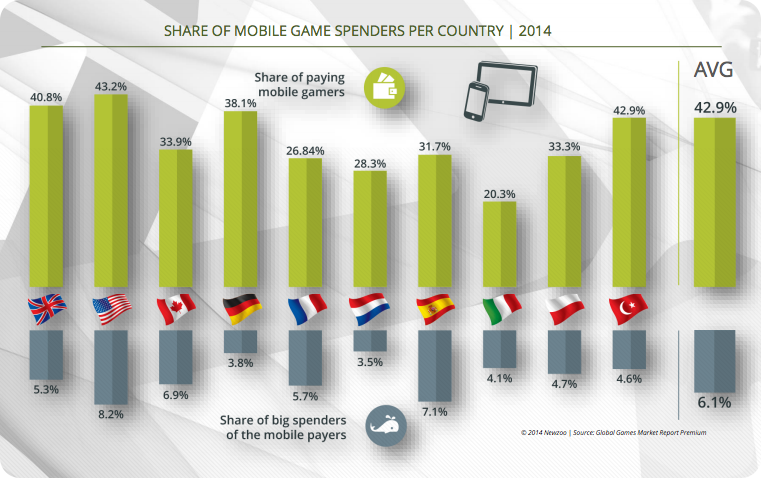
We in devtodev generally agree with similar statistics, however, we add that you can search for whales in the Arab countries (Saudi Arabia, UAE), we found them there.
But the statistics on the whales from GameAnalytics. It can be seen that there are more whales and dolphins (players with average amounts) among iOS users than among Android users.

First, whales have retention rates slightly higher than other paying, and especially non-paying, users. This is understandable - the whales “invested” considerable sums in the game and are interested in getting a return on their investment in the form of emotions.
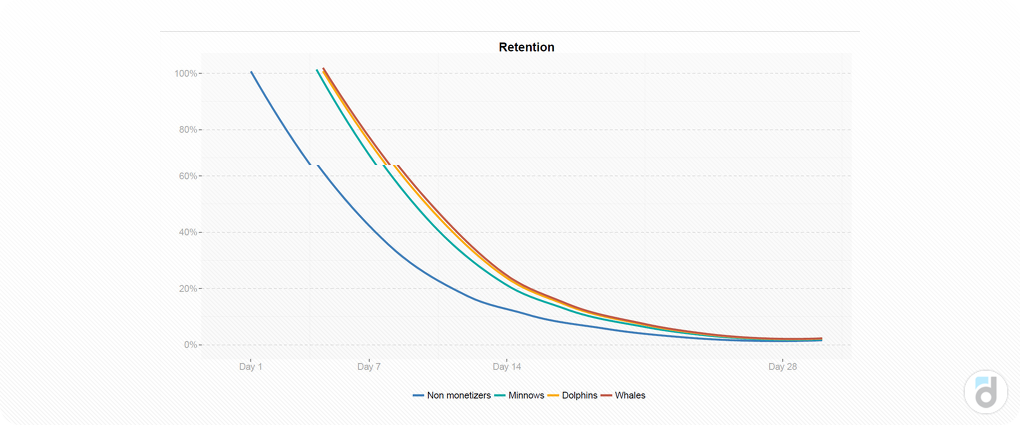
It is interesting, moreover, that by the regularity of entries into the game, paying users, and whales in particular, are inferior to non-paying ones. This can be explained by the fact that non-paying users need more sessions and time to earn virtual currency in the game. And those who paid may go less often and skim the cream off.
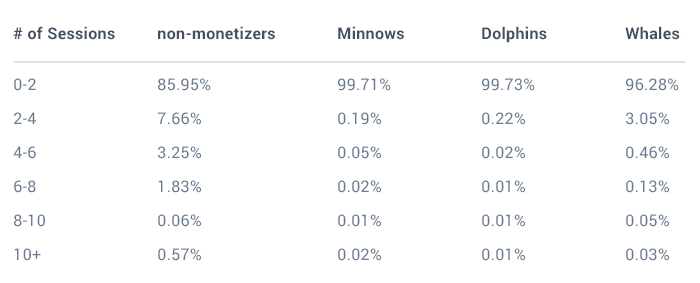
Referring to the fact that users prefer to pay in the game. Newzoo has some good research on this:

For what those who give the small sums pay (the reasons which have specified 20% of respondents and more):
What those who pay a lot pay for:
It turns out that users pay for more fun to play, for access to additional features (premium account) and for enhancing the skill to compete on equal terms with other players. Some of them are willing to pay very large sums of money.
It is very difficult to find whales, but their search is a serious and necessary task. Your player may well be a whale, he just does not know about it until he needs to pay. It is important that the project brings pleasure to the player, regardless of how much money he paid and whether he paid at all. If he does not want to pay, let him enjoy the game for free. If he is ready to give a lot of money - give him that opportunity.
In this sense, a good example (as, indeed, in many other situations) is Clash Royale.
The player receives new cards from the chests, but each chest takes time to unlock. The more valuable the chest, the longer it takes to open it. This process can be accelerated by paying for the crystals. However, crystals tend to end quickly, and real money will have to be paid for the purchase of new ones.
Those who do not want to pay, may well wait - for example, leave the chest open at night. And those who are willing to spend real money, can buy crystals and open the chests instantly. Thus, they will get an advantage (the same return on investment in the form of emotions), but sooner or later they will face a more serious rival. In addition, those who do not pay for the opening of the chest, after some time, “catch up” with those who pay, and again have to make money in the game to keep the advantage.
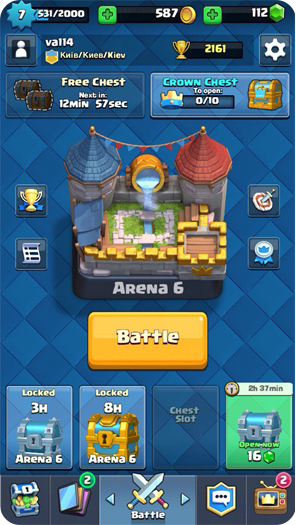
It turns out that in Clash Royale the player can spend any amount of money or not spend it eight. The game is well suited for non-paying, and for the whales, just everyone has their own speed of play and their need for emotions.
Whales bring a significant portion of the game's income. You all know the Pareto principle (20% of efforts give 80% of the result), and in game analytics this principle can be formulated like this: 20% of paying users give 80% of the game’s income. In other words, a small number of paying users brings a significant share of the total revenue of the game. In particular, in a recent study published on Venturebeat, it says that 0.19% of players bring in half of game income.
Here's what the report on segments of paying users looks like in devtodev . We have identified a separate category, Grand Whales (the top 1% of those who pay the most).


')
How to find whales?
This question is often asked by analysts. If the answer was so simple, all the whales would have been taken apart for a long time. You need to understand that the whale in your networks is an unlikely event, and it is difficult to predict it (just about how to predict an earthquake).
Moreover, if suddenly you found out that a whale “swelled” through one of the traffic channels, this does not mean that the entire marketing budget should be directed to this channel. Rather, on the contrary, when analyzing the quality of the traffic channels of this whale, it is better to deduct it so that it does not spoil the statistics.
Try searching for whales through analyzing your project by country or platform. Here, for example, statistics from Newzoo on the percentage of players who pay large sums by country.

We in devtodev generally agree with similar statistics, however, we add that you can search for whales in the Arab countries (Saudi Arabia, UAE), we found them there.
But the statistics on the whales from GameAnalytics. It can be seen that there are more whales and dolphins (players with average amounts) among iOS users than among Android users.

How do whales behave?
First, whales have retention rates slightly higher than other paying, and especially non-paying, users. This is understandable - the whales “invested” considerable sums in the game and are interested in getting a return on their investment in the form of emotions.

It is interesting, moreover, that by the regularity of entries into the game, paying users, and whales in particular, are inferior to non-paying ones. This can be explained by the fact that non-paying users need more sessions and time to earn virtual currency in the game. And those who paid may go less often and skim the cream off.

Referring to the fact that users prefer to pay in the game. Newzoo has some good research on this:

For what those who give the small sums pay (the reasons which have specified 20% of respondents and more):
- to unlock additional levels;
- to have fun playing.
What those who pay a lot pay for:
- to buy a premium account;
- to unlock additional levels;
- to make it more fun to play;
- to be able to compete with other players.
It turns out that users pay for more fun to play, for access to additional features (premium account) and for enhancing the skill to compete on equal terms with other players. Some of them are willing to pay very large sums of money.
It is very difficult to find whales, but their search is a serious and necessary task. Your player may well be a whale, he just does not know about it until he needs to pay. It is important that the project brings pleasure to the player, regardless of how much money he paid and whether he paid at all. If he does not want to pay, let him enjoy the game for free. If he is ready to give a lot of money - give him that opportunity.
In this sense, a good example (as, indeed, in many other situations) is Clash Royale.
The player receives new cards from the chests, but each chest takes time to unlock. The more valuable the chest, the longer it takes to open it. This process can be accelerated by paying for the crystals. However, crystals tend to end quickly, and real money will have to be paid for the purchase of new ones.
Those who do not want to pay, may well wait - for example, leave the chest open at night. And those who are willing to spend real money, can buy crystals and open the chests instantly. Thus, they will get an advantage (the same return on investment in the form of emotions), but sooner or later they will face a more serious rival. In addition, those who do not pay for the opening of the chest, after some time, “catch up” with those who pay, and again have to make money in the game to keep the advantage.

It turns out that in Clash Royale the player can spend any amount of money or not spend it eight. The game is well suited for non-paying, and for the whales, just everyone has their own speed of play and their need for emotions.
For those who are too lazy to read the whole text:
- whales are those who pay large sums of money;
- whales are best excluded from the analysis so that they do not spoil the statistics (especially by traffic channels);
- whales are hard to find, but trying is necessary (look for them in different countries and on different platforms);
- players pay to play more fun, to get additional features and to compensate for the lack of gaming skills;
- whales can be found among the players that already exist, just give the player the opportunity to spend the amount of money he wants to give (from zero to infinity).
Source: https://habr.com/ru/post/300094/
All Articles